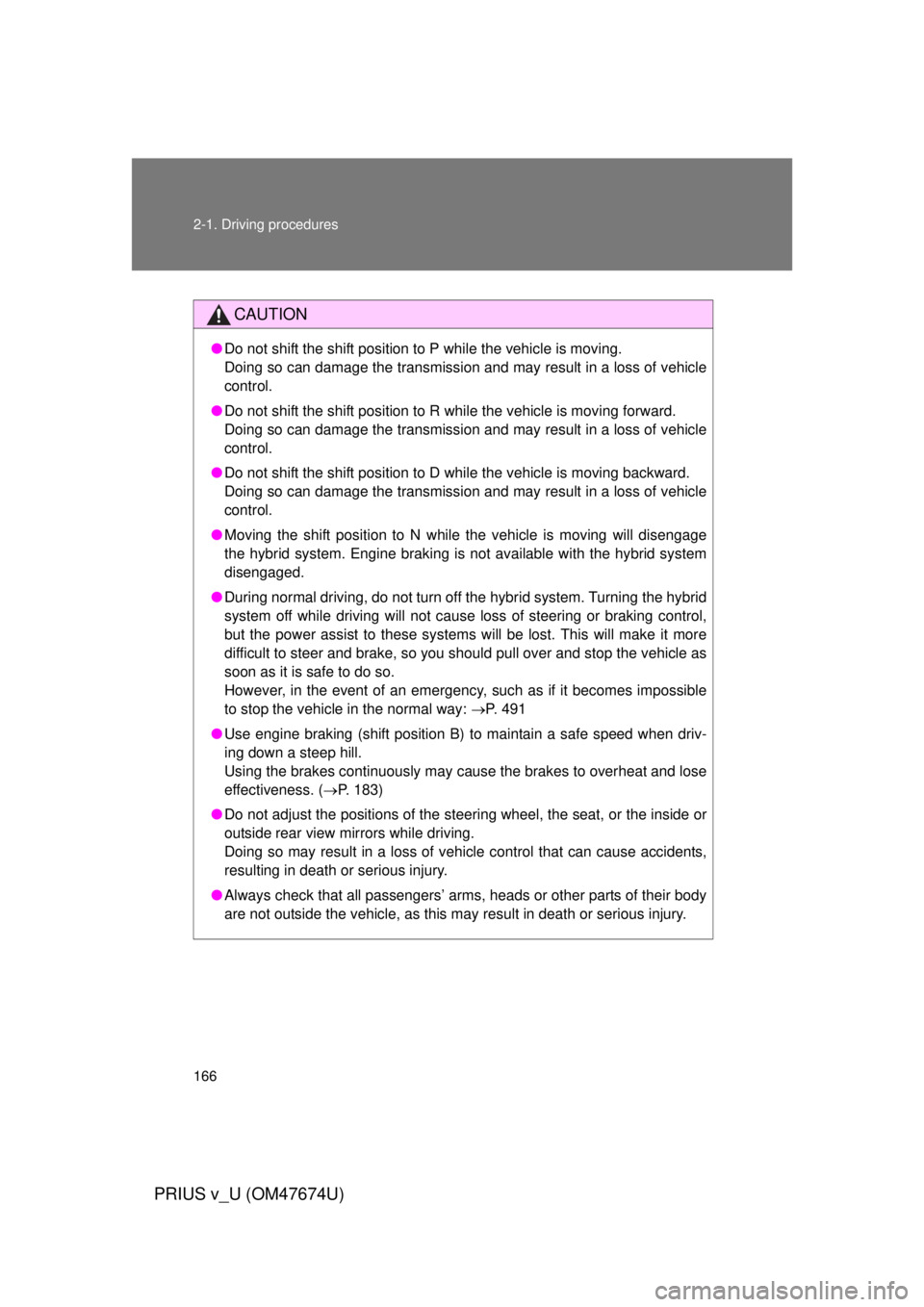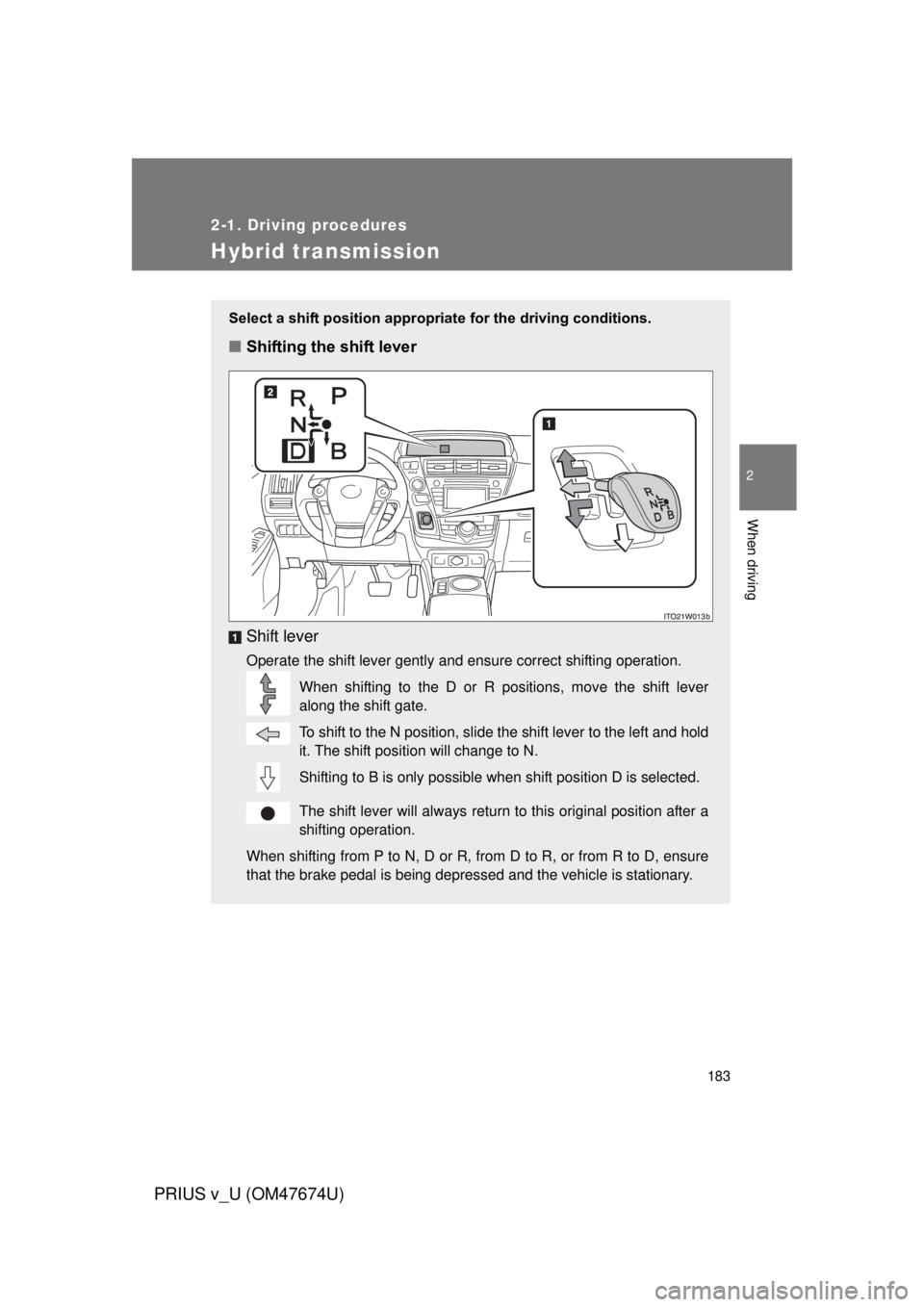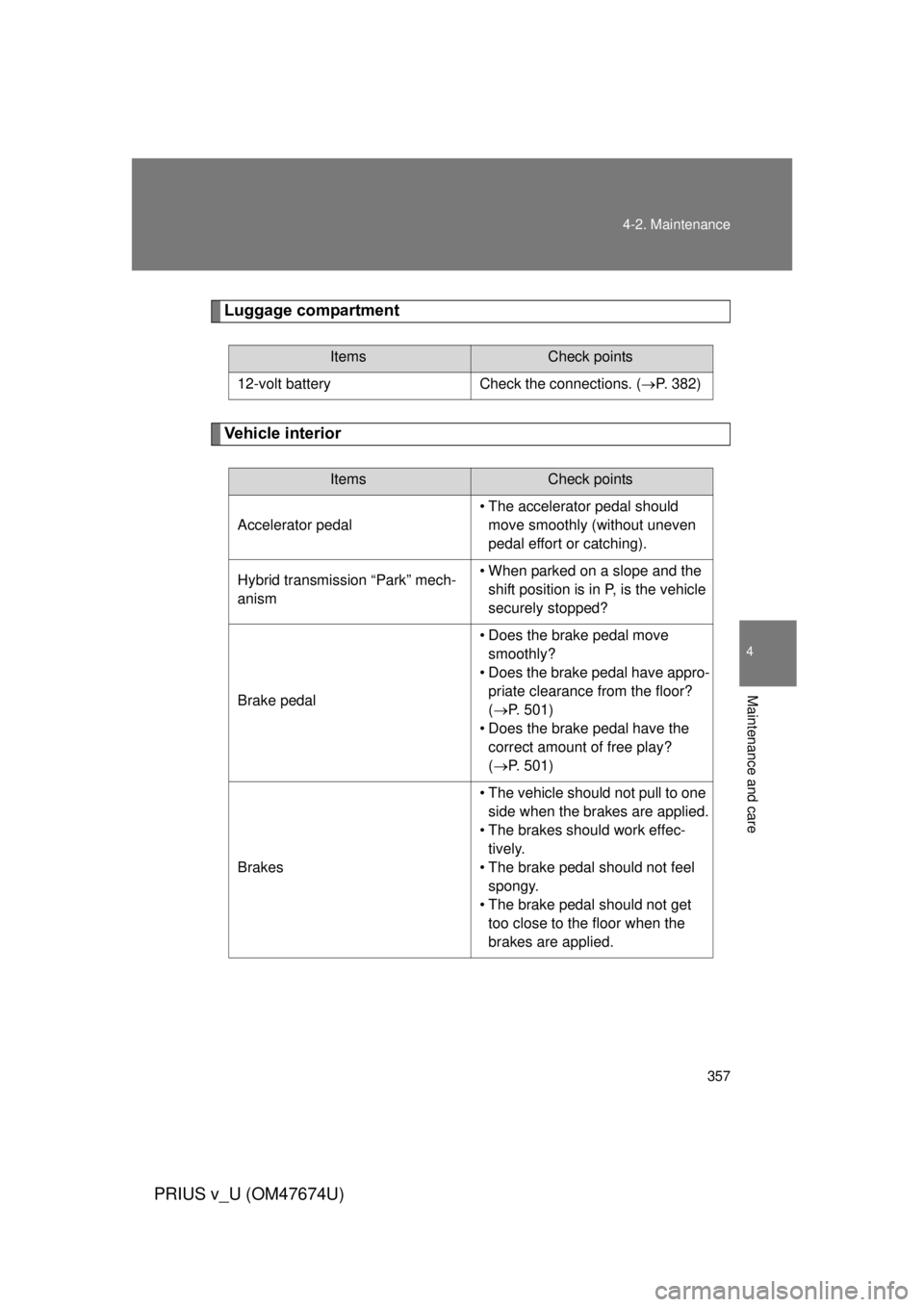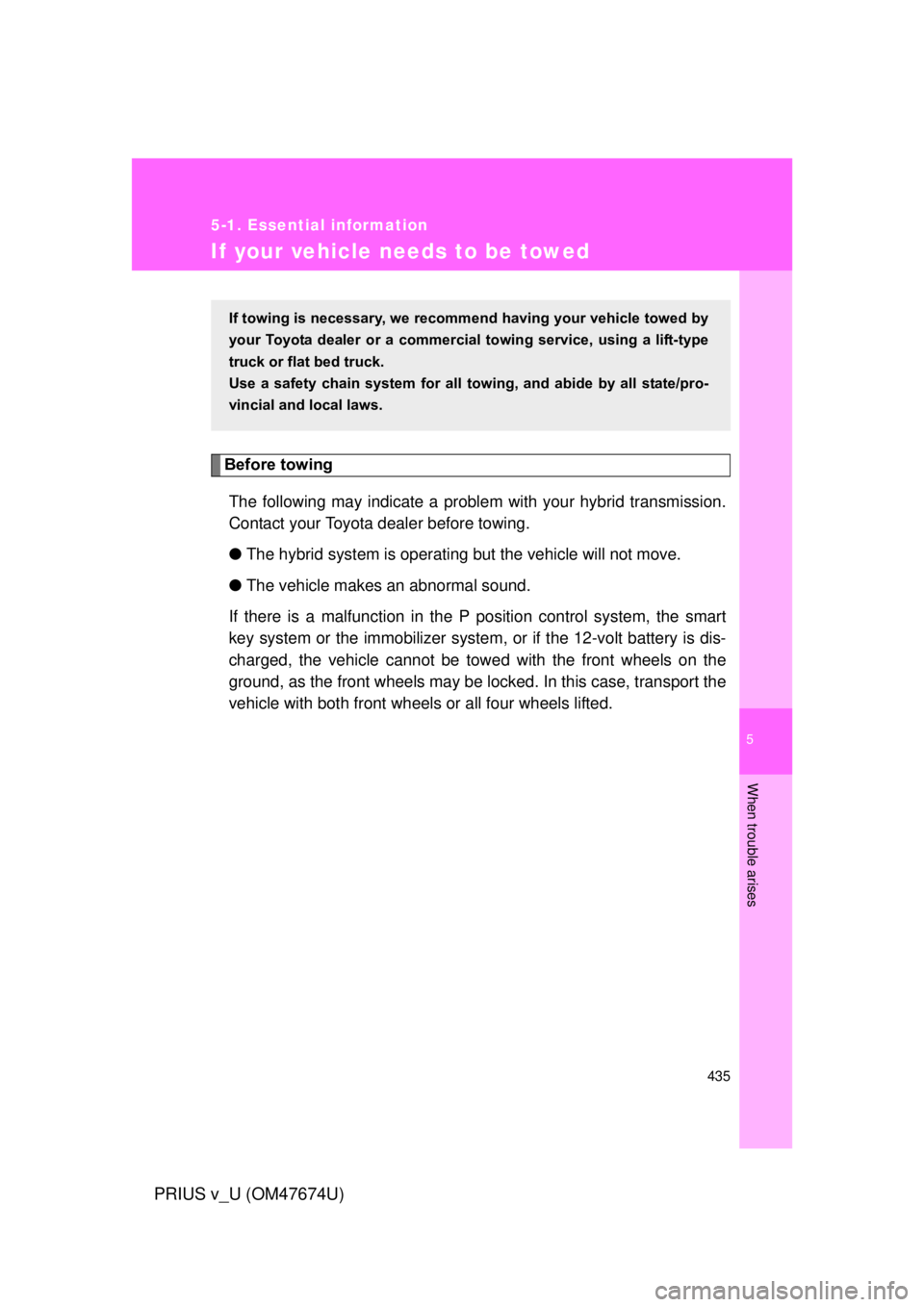transmission TOYOTA PRIUS V 2012 Owners Manual (in English)
[x] Cancel search | Manufacturer: TOYOTA, Model Year: 2012, Model line: PRIUS V, Model: TOYOTA PRIUS V 2012Pages: 564, PDF Size: 10.45 MB
Page 3 of 564

1
2
3
4
5
6
7
3
PRIUS v_U (OM47674U)
2-1. Driving proceduresDriving the vehicle............... 162
Power (ignition) switch ........ 173
EV drive mode .................... 180
Hybrid transmission ............ 183
Turn signal lever ................. 192
Parking brake ...................... 193
Horn .................................... 194
2-2. Instrument cluster Gauges and meters ............ 195
Indicators and warning lights ................................. 206
2-3. Operating the lights and windshield wipers
Headlight switch .................. 211
Fog light switch ................... 219
Windshield wipers and washer .............................. 221
Rear window wiper and washer .............................. 226
Headlight cleaner switch ..... 228 2-4. Using other driving systems
Cruise control ..................... 229
Dynamic radar cruise control .............................. 233
Driving assist systems ........ 250
Hill-start assist control ........ 254
PCS (Pre-Collision System) ............................ 256
2-5. Driving information Cargo and luggage ............. 264
Vehicle load limits............... 270
Winter driving tips ............... 271
Trailer towing ...................... 275
Dinghy towing ..................... 276
2When driving
Page 23 of 564

23
PRIUS v_U (OM47674U)
●Event data recorder
Your vehicle has computers that monitor and control certain aspects of your
vehicle. These computers assist in driving and maintaining optimal vehicle
performance.
Besides storing data useful for troubleshooting, there is an event data
recorder (EDR) that records data in a crash or near crash event.
The SRS airbag sensor assembly contains the EDR. In a crash or near crash
event, this device may record the following information:
• Engine speed
• Whether the brake pedal was depressed or not
• Vehicle speed
• To what extent the accelerator pedal was depressed
• Hybrid transmission shift position
• Whether the driver and front passenger wore seat belts or not
• Driver’s seat position
• SRS airbag deployment data
• SRS airbag system diagnostic data
• Front passenger’s occupant classification
The information above is intended to be used for the purpose of improving
vehicle safety performance. Unlike general data recorders, the EDR does
not record sound data such as conversation between passengers.
● Disclosure of the EDR data
Toyota will not disclose the data recorded in an EDR to a third party except
when:
• An agreement from the vehicle’s owner (or the leasing company for a leased vehicle) is obtained
• Officially requested to by the police or other authorities
• Necessary, for use as a defense for Toyota in a lawsuit
• Ordered to by a court of law
However, if necessary, Toyota will:
• Use the data for research on Toyota vehicle safety performance
• Disclose the data to a third party for research purposes without disclosing details of the vehicle owner, and that only when deemed necessary
• Disclose summarized data cleared of vehicle identification information to a non-Toyota organization for research purposes
Page 32 of 564

32 1-1. Hybrid system
PRIUS v_U (OM47674U)
■Sounds and vibrations specific to a hybrid vehicle
There may be no engine sounds or vibration even though the vehicle is able
to move. For safety, apply the parking brake and make sure to shift the shift
position to P when parked.
The following sounds or vibrations may occur when the hybrid system is
operating and are not a malfunction:
● The brake system operation sound heard from the front of the vehicle
when the driver’s door is opened.
● Motor sounds may be heard from the engine compartment.
● Sounds may be heard from the hybrid battery (traction battery) when the
hybrid system starts or stops.
● Sounds may be heard from the transmission when the gasoline engine
starts or stops, when driving at low speeds, or during idling.
● Engine sounds may be heard when accelerating sharply.
● Sounds may be heard due to regenerative braking when the brake pedal
is depressed and accelerator is loosened.
● Other sounds, such as motors and mechanical noises, may be heard
from the brake system when the brake pedal is depressed.
● Vibration may be felt when the gasoline engine starts or stops.
● Cooling fan sounds may be heard from the air intake vent. (
P. 35)
● The operation sound of the air conditioning system (air conditioning com-
pressor, blower motor).
Page 161 of 564

When driving2
161
PRIUS v_U (OM47674U)
2-1. Driving proceduresDriving the vehicle............ 162
Power (ignition) switch ..... 173
EV drive mode ................. 180
Hybrid transmission ......... 183
Turn signal lever .............. 192
Parking brake ................... 193
Horn ................................. 194
2-2. Instrument cluster Gauges and meters ......... 195
Indicators and warning lights .............................. 206 2-3. Operating the lights and
windshield wipers
Headlight switch ............... 211
Fog light switch ................ 219
Windshield wipers and washer ........................... 221
Rear window wiper and washer ........................... 226
Headlight cleaner switch ............................. 228
2-4. Using other driving systems Cruise control ................... 229
Dynamic radar cruise control ............................ 233
Driving assist systems ..... 250
Hill-start assist control ...... 254
PCS (Pre-Collision System) .......................... 256
2-5. Driving information Cargo and luggage .......... 264
Vehicle load limits ............ 270
Winter driving tips ............ 271
Trailer towing ................... 275
Dinghy towing .................. 276
Page 166 of 564

166 2-1. Driving procedures
PRIUS v_U (OM47674U)
CAUTION
●Do not shift the shift position to P while the vehicle is moving.
Doing so can damage the transmission and may result in a loss of vehicle\
control.
● Do not shift the shift position to R while the vehicle is moving forward.
Doing so can damage the transmission and may result in a loss of vehicle\
control.
● Do not shift the shift position to D while the vehicle is moving backward.
Doing so can damage the transmission and may result in a loss of vehicle\
control.
● Moving the shift position to N while the vehicle is moving will disengage
the hybrid system. Engine braking is not available with the hybrid system
disengaged.
● During normal driving, do not turn off the hybrid system. Turning the hybrid
system off while driving will not cause loss of steering or braking control,
but the power assist to these systems will be lost. This will make it more
difficult to steer and brake, so you should pull over and stop the vehicle as
soon as it is safe to do so.
However, in the event of an emergency, such as if it becomes impossible
to stop the vehicle in the normal way: P. 491
● Use engine braking (shift position B) to maintain a safe speed when driv-
ing down a steep hill.
Using the brakes continuously may cause the brakes to overheat and lose
effectiveness. (P. 183)
● Do not adjust the positions of the steering wheel, the seat, or the inside or
outside rear view mirrors while driving.
Doing so may result in a loss of vehicle control that can cause accidents,
resulting in death or serious injury.
● Always check that all passengers’ arms, heads or other parts of their body
are not outside the vehicle, as this may result in death or serious injury.
Page 172 of 564

172 2-1. Driving procedures
PRIUS v_U (OM47674U)
NOTICE
■When encountering flooded roads
Do not drive on a road that has flooded after heavy rain etc. Doing so may
cause the following serious damage to the vehicle:
● Engine stalling
● Short in electrical components
● Engine damage caused by water immersion
In the event that you drive on a flooded road and the vehicle is flooded, be
sure to have your Toyota dealer check the following:
● Brake function
● Changes in quantity and quality of engine oil, transmission fluid for the
hybrid system, etc.
● Lubricant condition for the bearings and suspension joints (where possi-
ble), and the function of all joints, bearings, etc.
If the P position control system is damaged by flooding, it may not be possi-
ble to shift the shift position to P, or from P to other positions. When the shift
position cannot be changed from P to any other position, the front wheels
will lock, and you will be unable to tow the vehicle with the front wheels on
the ground, as the front wheels may be locked. In this case, transport the
vehicle with both front wheels or all four wheels lifted.
Page 183 of 564

183
2-1. Driving procedures
PRIUS v_U (OM47674U)
2
When driving
Hybrid transmission
Select a shift position appropriate for the driving conditions.
■Shifting the shift lever
Shift lever
Operate the shift lever gently and ensure correct shifting operation.
When shifting to the D or R positions, move the shift lever
along the shift gate.
To shift to the N position, slide the shift lever to the left and hold
it. The shift position will change to N.
Shifting to B is only possible when shift position D is selected.
The shift lever will always return to this original position after a
shifting operation.
When shifting from P to N, D or R, from D to R, or from R to D, ensure
that the brake pedal is being depressed and the vehicle is stationary.
Page 357 of 564

357
4-2. Maintenance
PRIUS v_U (OM47674U)
4
Maintenance and care
Luggage compartment
Vehicle interior
ItemsCheck points
12-volt battery Check the connections. (P. 382)
ItemsCheck points
Accelerator pedal
• The accelerator pedal should
move smoothly (without uneven
pedal effort or catching).
Hybrid transmission “Park” mech-
anism • When parked on a slope and the
shift position is in P, is the vehicle
securely stopped?
Brake pedal • Does the brake pedal move
smoothly?
• Does the brake pedal have appro- priate clearance from the floor?
(P. 501)
• Does the brake pedal have the correct amount of free play?
(P. 501)
Brakes • The vehicle should not pull to one
side when the brakes are applied.
• The brakes should work effec- tively.
• The brake pedal should not feel spongy.
• The brake pedal should not get too close to the floor when the
brakes are applied.
Page 416 of 564

416 4-3. Do-it-yourself maintenance
PRIUS v_U (OM47674U)
FUSEAmpereCircuit
26 WIP 30A Windshield wipers
27 MET 7.5A Gauges and meters
28 IGN 10ABrake system, driver support sys-
tem, multiport fuel injection sys-
tem/sequential multiport fuel
injection system, SRS airbag sys-
tem, occupant detection system
(ECU and sensors), smart key
system
29 PANEL 10AAir conditioning system, emer-
gency flashers, seat heaters,
transmission, P position switch,
navigation system, advanced
parking guidance system, head-
light cleaner, seat belt reminder
light, headlight leveling system,
glove box light, clock, audio sys-
tem
30 TAIL 10AHeadlight leveling system, park-
ing lights, tail lights, license plate
lights, front fog lights, side marker
lights
Page 435 of 564

5
When trouble arises
435
5-1. Essential information
PRIUS v_U (OM47674U)
If your vehicle needs to be towed
Before towingThe following may indicate a problem with your hybrid transmission.
Contact your Toyota dealer before towing.
● The hybrid system is operating but the vehicle will not move.
● The vehicle makes an abnormal sound.
If there is a malfunction in the P position control system, the smart
key system or the immobilizer system , or if the 12-volt battery is dis-
charged, the vehicle cannot be tow ed with the front wheels on the
ground, as the front wheels may be locked. In this case, transport the
vehicle with both front wheels or all four wheels lifted.
If towing is necessary, we recommend having your vehicle towed by
your Toyota dealer or a commerci al towing service, using a lift-type
truck or flat bed truck.
Use a safety chain system for all to wing, and abide by all state/pro-
vincial and local laws.